Video-call.live is a website that lures computer users into registering for its push notifications to send unwanted adverts directly to the web browser. This web-page will display the ‘Show notifications’ prompt states that clicking ‘Allow’ button will let the user connect to the Internet, watch a video, access the content of the web-site, enable Flash Player, download a file, and so on.
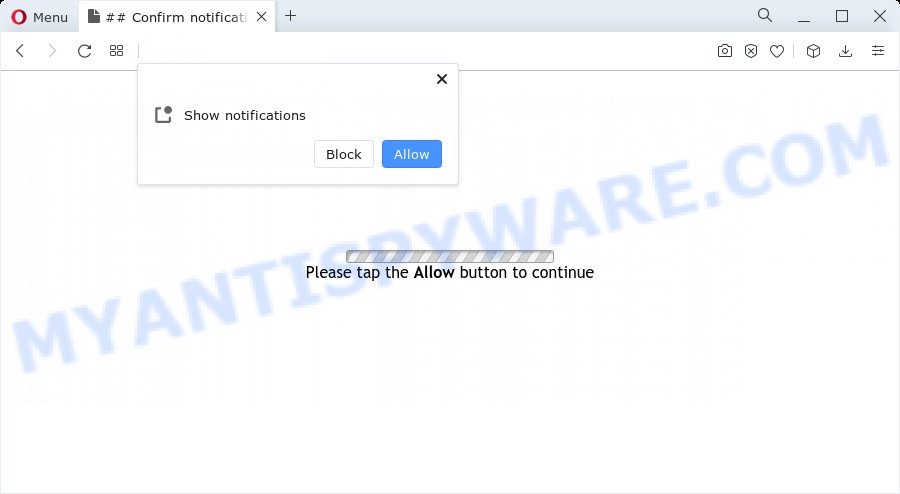
Once you click on the ‘Allow’, then your browser will be configured to display unwanted ads on your desktop, even when you are not using the browser. Push notifications are originally developed to alert the user of recently published content. Scammers abuse ‘push notifications’ to avoid anti-virus and ad-blocker software by presenting annoying adverts. These ads are displayed in the lower right corner of the screen urges users to play online games, visit suspicious web-pages, install web browser plugins & so on.

If you’re getting push notifications, you can get rid of Video-call.live subscription by going into your web-browser’s settings and completing the Video-call.live removal guide below. Once you delete Video-call.live subscription, the browser notification spam will no longer show on your screen.
Threat Summary
| Name | Video-call.live pop-up |
| Type | push notifications ads, popup advertisements, pop ups, pop up virus |
| Distribution | adware, suspicious pop-up ads, social engineering attack, potentially unwanted applications |
| Symptoms |
|
| Removal | Video-call.live removal guide |
How did you get infected with Video-call.live pop-ups
Computer security experts have determined that users are rerouted to Video-call.live by adware software or from misleading ads. Adware is ‘advertising supported’ software that tries to generate profit by redirecting you to annoying webpages or online adverts. It has different methods of earning profit including showing up adverts on the internet browser forcefully. Most of adware gets installed when you’re downloading freeware or browser plugins.
Adware comes to the PC as part of the installer of various freeware. Thus on the process of installation, it will be installed onto your PC system and/or internet browser. In order to avoid adware software, you just need to follow a few simple rules: carefully read the Terms of Use and the license, choose only a Manual, Custom or Advanced installation mode, which enables you to make sure that the program you want to install, thereby protect your PC system from adware software.
Below we are discussing the methods which are very useful in deleting adware software. The guidance will also allow you to remove Video-call.live advertisements from your internet browser for free.
How to remove Video-call.live pop ups from Chrome, Firefox, IE, Edge
Even if you’ve the up-to-date classic antivirus installed, and you’ve checked your computer for malware and removed anything found, you need to do the guide below. The Video-call.live ads removal is not simple as installing another antivirus. Classic antivirus software are not designed to run together and will conflict with each other, or possibly crash MS Windows. Instead we advise complete the manual steps below after that use Zemana, MalwareBytes AntiMalware (MBAM) or Hitman Pro, which are free applications dedicated to search for and delete adware which causes intrusive Video-call.live ads. Use these tools to ensure the adware is removed.
To remove Video-call.live pop ups, perform the following steps:
- Manual Video-call.live popups removal
- Automatic Removal of Video-call.live pop-up advertisements
- How to block Video-call.live
- Finish words
Manual Video-call.live popups removal
In this section of the blog post, we have posted the steps that will help to get rid of Video-call.live pop up ads manually. Although compared to removal utilities, this method loses in time, but you don’t need to install anything on your device. It will be enough for you to follow the detailed guidance with pictures. We tried to describe each step in detail, but if you realized that you might not be able to figure it out, or simply do not want to change the Windows and web-browser settings, then it’s better for you to run utilities from trusted developers, which are listed below.
Uninstall newly installed PUPs
Some potentially unwanted programs, browser hijacking applications and adware can be deleted by uninstalling the freeware they came with. If this way does not succeed, then looking them up in the list of installed software in MS Windows Control Panel. Use the “Uninstall” command in order to remove them.
|
|
|
|
Remove Video-call.live notifications from web browsers
if you became a victim of fraudsters and clicked on the “Allow” button, then your web browser was configured to display annoying ads. To remove the advertisements, you need to get rid of the notification permission that you gave the Video-call.live web-site to send push notifications.
|
|
|
|
|
|
Remove Video-call.live popups from Chrome
If adware, other application or plugins replaced your Chrome settings without your knowledge, then you can remove Video-call.live advertisements and revert back your web browser settings in Google Chrome at any time. Your saved bookmarks, form auto-fill information and passwords won’t be cleared or changed.

- First, launch the Google Chrome and press the Menu icon (icon in the form of three dots).
- It will show the Chrome main menu. Select More Tools, then click Extensions.
- You’ll see the list of installed extensions. If the list has the plugin labeled with “Installed by enterprise policy” or “Installed by your administrator”, then complete the following steps: Remove Chrome extensions installed by enterprise policy.
- Now open the Chrome menu once again, click the “Settings” menu.
- Next, click “Advanced” link, which located at the bottom of the Settings page.
- On the bottom of the “Advanced settings” page, click the “Reset settings to their original defaults” button.
- The Google Chrome will show the reset settings prompt as shown on the screen above.
- Confirm the web browser’s reset by clicking on the “Reset” button.
- To learn more, read the post How to reset Google Chrome settings to default.
Remove Video-call.live from Mozilla Firefox by resetting internet browser settings
If the Mozilla Firefox browser program is hijacked, then resetting its settings can help. The Reset feature is available on all modern version of Firefox. A reset can fix many issues by restoring Firefox settings such as home page, search provider by default and newtab page to their original settings. When using the reset feature, your personal information like passwords, bookmarks, browsing history and web form auto-fill data will be saved.
First, launch the Firefox. Next, click the button in the form of three horizontal stripes (![]() ). It will open the drop-down menu. Next, click the Help button (
). It will open the drop-down menu. Next, click the Help button (![]() ).
).

In the Help menu click the “Troubleshooting Information”. In the upper-right corner of the “Troubleshooting Information” page click on “Refresh Firefox” button as shown on the image below.

Confirm your action, press the “Refresh Firefox”.
Delete Video-call.live pop-ups from IE
If you find that Microsoft Internet Explorer internet browser settings such as new tab page, start page and search provider had been modified by adware that causes multiple annoying popups, then you may restore your settings, via the reset internet browser procedure.
First, open the Internet Explorer. Next, click the button in the form of gear (![]() ). It will open the Tools drop-down menu, click the “Internet Options” like below.
). It will open the Tools drop-down menu, click the “Internet Options” like below.

In the “Internet Options” window click on the Advanced tab, then click the Reset button. The Internet Explorer will show the “Reset Internet Explorer settings” window as displayed on the screen below. Select the “Delete personal settings” check box, then click “Reset” button.

You will now need to reboot your personal computer for the changes to take effect.
Automatic Removal of Video-call.live pop-up advertisements
It’s not enough to get rid of Video-call.live ads from your browser by completing the manual steps above to solve all problems. Some the adware software related files may remain on your PC and they will recover the adware even after you delete it. For that reason we advise to use free anti malware tool like Zemana Free, MalwareBytes Anti-Malware (MBAM) and HitmanPro. Either of those applications should has the ability to search for and remove adware that causes multiple intrusive pop-ups.
Use Zemana AntiMalware (ZAM) to remove Video-call.live popups
Zemana Anti-Malware is a complete package of anti malware utilities. Despite so many features, it does not reduce the performance of your PC system. Zemana has the ability to delete almost all the types of adware software including Video-call.live ads, browser hijackers, potentially unwanted programs and harmful web browser addons. Zemana has real-time protection that can defeat most malware. You can run Zemana Anti-Malware (ZAM) with any other antivirus software without any conflicts.
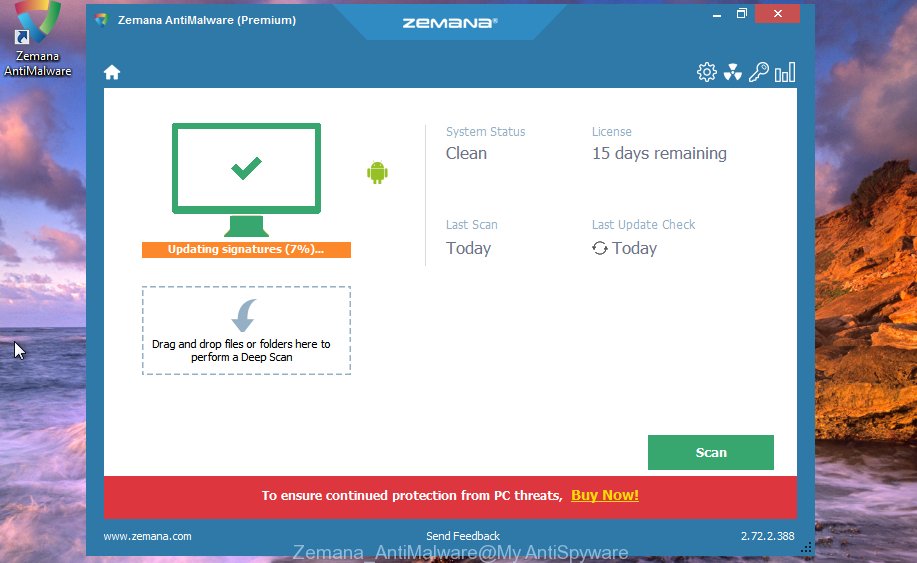
- Download Zemana Free on your Windows Desktop from the following link.
Zemana AntiMalware
165076 downloads
Author: Zemana Ltd
Category: Security tools
Update: July 16, 2019
- At the download page, click on the Download button. Your web-browser will display the “Save as” dialog box. Please save it onto your Windows desktop.
- After the download is done, please close all applications and open windows on your computer. Next, run a file called Zemana.AntiMalware.Setup.
- This will launch the “Setup wizard” of Zemana Anti-Malware onto your PC. Follow the prompts and don’t make any changes to default settings.
- When the Setup wizard has finished installing, the Zemana AntiMalware will open and open the main window.
- Further, click the “Scan” button to find adware that causes multiple intrusive popups. This procedure may take quite a while, so please be patient. During the scan Zemana will scan for threats present on your computer.
- Once the scan get completed, it will open the Scan Results.
- You may remove threats (move to Quarantine) by simply click the “Next” button. The tool will get rid of adware that causes multiple unwanted pop ups and move the selected threats to the Quarantine. When the cleaning procedure is complete, you may be prompted to restart the PC system.
- Close the Zemana and continue with the next step.
Use HitmanPro to get rid of Video-call.live ads
If the Video-call.live pop-ups issue persists, run the Hitman Pro and check if your device is affected by adware software. The Hitman Pro is a downloadable security utility that provides on-demand scanning and helps remove adware, potentially unwanted applications, and other malicious software. It works with your existing anti-virus.
Download HitmanPro on your Microsoft Windows Desktop from the link below.
After downloading is complete, open the file location and double-click the HitmanPro icon. It will launch the HitmanPro tool. If the User Account Control dialog box will ask you want to launch the application, click Yes button to continue.
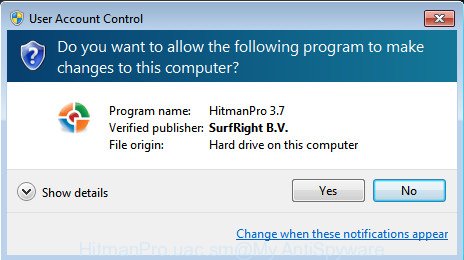
Next, click “Next” to start checking your personal computer for the adware software that causes Video-call.live advertisements. A system scan may take anywhere from 5 to 30 minutes, depending on your computer. While the tool is checking, you can see number of objects and files has already scanned.
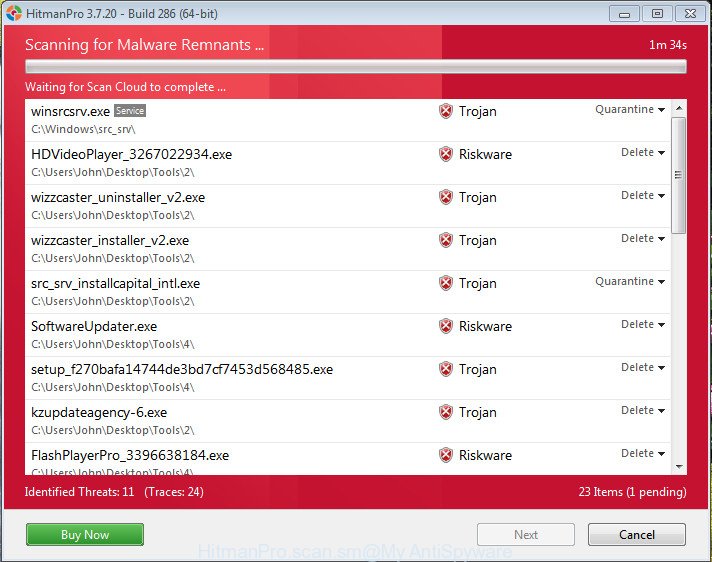
When HitmanPro is complete scanning your PC, you may check all items detected on your PC like below.
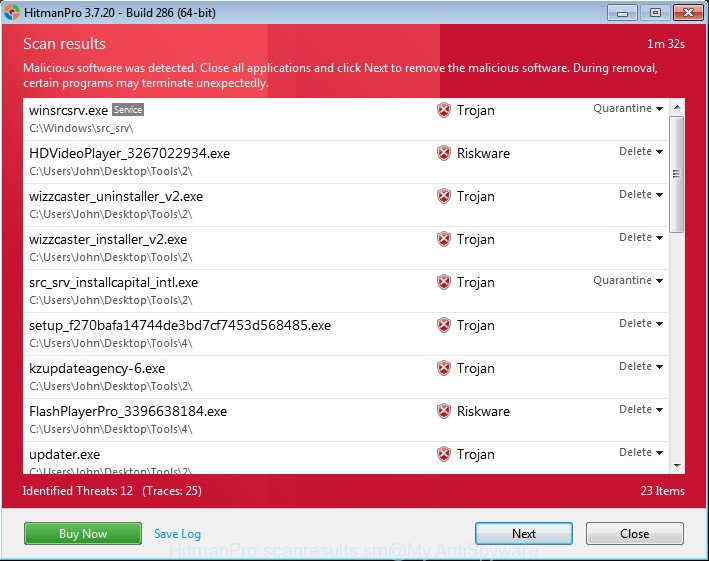
Review the results once the tool has done the system scan. If you think an entry should not be quarantined, then uncheck it. Otherwise, simply click “Next” button. It will open a dialog box, press the “Activate free license” button. The HitmanPro will remove adware software which cause annoying Video-call.live popups and move the selected threats to the Quarantine. After finished, the utility may ask you to reboot your computer.
Use MalwareBytes Free to remove Video-call.live pop ups
Manual Video-call.live popup ads removal requires some computer skills. Some files and registry entries that created by the adware software can be not completely removed. We suggest that run the MalwareBytes that are completely clean your device of adware software. Moreover, the free program will help you to delete malware, PUPs, browser hijackers and toolbars that your personal computer can be infected too.
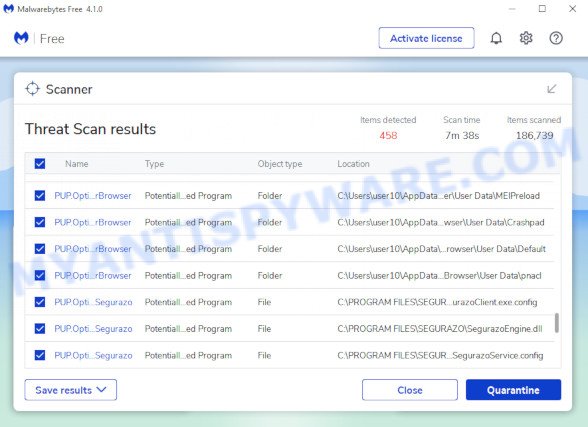
- Download MalwareBytes Free by clicking on the link below. Save it to your Desktop.
Malwarebytes Anti-malware
327297 downloads
Author: Malwarebytes
Category: Security tools
Update: April 15, 2020
- When the downloading process is finished, close all software and windows on your PC. Open a folder in which you saved it. Double-click on the icon that’s named MBsetup.
- Select “Personal computer” option and click Install button. Follow the prompts.
- Once install is finished, click the “Scan” button . MalwareBytes program will scan through the whole device for the adware software that causes Video-call.live ads. This process can take quite a while, so please be patient. When a threat is found, the number of the security threats will change accordingly. Wait until the the scanning is finished.
- When MalwareBytes Anti Malware has finished scanning your device, MalwareBytes Anti-Malware will display a list of all items detected by the scan. Make sure all items have ‘checkmark’ and click “Quarantine”. After finished, you can be prompted to reboot your computer.
The following video offers a guide on how to get rid of hijackers, adware and other malware with MalwareBytes AntiMalware.
How to block Video-call.live
It is important to use adblocker apps such as AdGuard to protect your device from harmful web-sites. Most security experts says that it’s okay to block ads. You should do so just to stay safe! And, of course, the AdGuard can to block Video-call.live and other undesired web pages.
AdGuard can be downloaded from the following link. Save it on your Microsoft Windows desktop or in any other place.
26905 downloads
Version: 6.4
Author: © Adguard
Category: Security tools
Update: November 15, 2018
When the downloading process is done, run the downloaded file. You will see the “Setup Wizard” screen such as the one below.
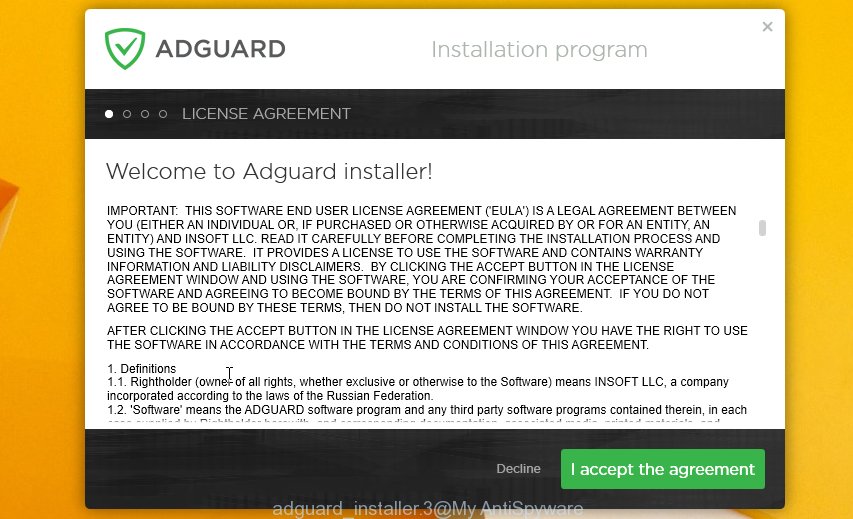
Follow the prompts. When the installation is finished, you will see a window as shown in the following example.

You can click “Skip” to close the installation program and use the default settings, or press “Get Started” button to see an quick tutorial that will help you get to know AdGuard better.
In most cases, the default settings are enough and you do not need to change anything. Each time, when you start your computer, AdGuard will run automatically and stop undesired ads, block Video-call.live, as well as other harmful or misleading web pages. For an overview of all the features of the application, or to change its settings you can simply double-click on the AdGuard icon, which can be found on your desktop.
Finish words
Once you have complete the step-by-step guide shown above, your PC system should be free from adware software that cause intrusive Video-call.live pop ups and other malicious software. The Microsoft Edge, Internet Explorer, Mozilla Firefox and Google Chrome will no longer redirect you to various annoying web-pages like Video-call.live. Unfortunately, if the steps does not help you, then you have caught a new adware, and then the best way – ask for help here.



















